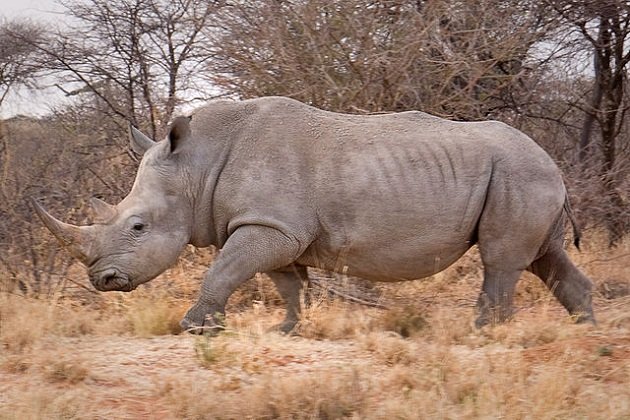
The annual number of rhino poached in South Africa last year rose to 1,215, Environmental Affairs Minister Edna Molewa told a media briefing in Pretoria two weeks ago. On average, over 100 rhinos were illegally killed each month. The World Wide Fund for Nature (WWF) said the figures showed a 21% increase in poaching from 2013, topping that year’s total by 195. Molewa added that so far this year 49 rhino had been killed countrywide.
Let’s slow down at this moment and go back in time… July is the coldest of winter months in the south of Africa. I was sitting in an open Land Cruiser, inhaling the fresh desert air that was getting cooler with each breath. Close to the Equator, the Sun was going down fast, towards the flat horizon of thorny acacias and dry grass.
In front of us, next to a waterhole was a small acacia with several Cape Glossy Starlings roosting in its crown for the night. A pair of screeching Blacksmith Lapwings was flying around as six Burchell’s Zebras were quenching their thirst, suspiciously observing surroundings every now and then. We haven’t seen the reason yet, but suddenly you could have palpated a tension in the air that made the zebras step away and even one female Ostrich stand up…
Then the Lord of the waterhole came, a young – although nine years old White Rhinoceros. The bull weighing almost two tones stopped at the edge of the clearing to sniff the air. The Sun was half-set behind the horizon, painting the grass golden-yellow and shining through the dust disturbed by the hoofs of now visibly nervous zebras.
H. offered me a glass of Campari liqueur and there we were, enveloped by the tranquility of a sunset in a thorny savanna observing a rhino lowering its massive head to the water. The sky was becoming orange-pink; its reflections were colouring the water, while the rhino raised its head, water sipping through his half-open snout, itself shining from the last sun rays of the day.
One Springbok gazelle came to drink, but kept a respectful distance staying by the smaller puddle. The sky was turning colours and the lower, dark-blue layer was clearly distinct from the higher yellowish one: the blue was the shadow of the Earth (the Sun has just set behind the horizon), while the higher one was still sunny…
 Data published by South African Department of Environmental Affairs (2015)
Data published by South African Department of Environmental Affairs (2015)
Fast-forward to the present murky sky and the 1,215 rhino butchered last year. But that is not all, Save the Survivor – a non-governmental organisation taking on an increasing number of injured or orphaned rhino and giving them a second chance – says the actual rhino-poaching statistics for 2014 are 30% higher than the official tally and the number of rhino killed could be as many as 1,700!
The official statistics don’t include baby rhino that died after their mothers were poached, nor do they include rhino that died during botched poaching attempts when the poachers were unable to remove the horn. It also excludes cases where the horn has been removed, but the rhino survived the attack, Save the Survivor experts say.
WWF states that the “killing on this scale shows how rhino poaching is being increasingly undertaken by organised criminal syndicates,” and announces, “all eyes will now be on the next major conference on the illegal wildlife trade to be held in Botswana in March, where governments from around the world will take further steps to fight the trade and save the rhino.”
My eyes will be returning to the lonely acacia next to a waterhole, trying to spot a large shadow in the sunset. White Rhino lifespan is 40 to 50 years, but I am wondering if “my” rhino is still alive?
Cover photo: White Rhinoceros, Wikimedia Commons.













In late 1987 I found myself wandering around Meru NP in Kenya. At that time they had 4 White Rhino that I believe were guarded 24/7. Those rhino were fairly tame and approachable. Then a couple years later, in 1989, I found myself at a wildlife talk in South Africa. It was the same never-ending story about poaching. I was surprised to learn that the 4 Kenyan Whhite Rhinos had been slaughtered, and I believe some of the guards as well.
While poaching is more akin to free market principles, you still have people hunting rhino and you have one of the (former) presidents of the WWF killing elephants. That’s just so sad. Surmountable problems that will never get solved because the political will will never be there. And it’s not like people didn’t know this 100 years ago: when these creatures (and trees) are removed from the earth, they will never be replaced. As long as humans are around anyway.
It’s been a bad year here. But, I’m having dinner with those fighting on the other side too. Don’t lose hope. They are fighting and fighting smart.
Good to hear, that is the answer I was looking for.
If I could contribute, count me in.